Almost all scientists in the world are convinced that an insufficient number of enzymes inside a person causes certain diseases. Indeed, without these compounds, life will inevitably slow down, and sometimes even stop altogether. In biology, catalysis of such substances makes food useful and accelerates all internal processes.
Record content:
- 1 Determination of enzymes
- 2 Classes
- 3 Role and practical use
- 4 Enzyme composition
- 5 Enzyme nomenclature and classification
- 6 Features and properties of enzymes
- 7 Functions and mechanism of action
- 8 Distribution in the body
- 9 Enzyme synthesis process
- 10 Human enzymes and hereditary diseases
- 11 Interesting Facts
- 12 Videos about enzymes in biology
Determination of enzymes
From latin the term "enzymes" is translated as "fermentation". These elements are also called enzymes, which in Greek means "in yeast". These substances are cellular compounds. These bio-catalysts provide the required standard of living. Thanks to them, all processes and reactions in the body proceed quite clearly and quickly.
Additional use of enzymes from other sources is needed:
- athletes;
- patients with enzyme dysfunction;
- those who are recovering from illness;
- children and people in adulthood;
- patients with poor health;
- infirm and early beginning to grow old;
- disabled people;
- those who have weight problems;
- people who eat large amounts of meat;
- vegetarians;
- suffering from sexual dysfunction;
- pregnant women and women who have recently given birth;
- people with liver and digestive problems;
- neurasthenics.
Classes
All enzymes are subdivided into:
- Oxidoreductases, consisting of heme and vitamin. These enzymes are subdivided into 17 subgroups and are involved in redox processes. Enzymes of this class include:
- Dehydrogenases, they split hydrogen atoms and move them to the next substrate. This enzyme subgroup acts in the processes of photosynthesis and respiration.
 It contains:
It contains:
- isocitrate dehydrogenase;
- liver enzymes;
- cytochrome reductase;
- pyruvate dehydrogenase.
- Oxidases (tyrosinase and cytochrome oxidase) that catalyze the combination of oxygen and hydrogen.
- Lipoxygenase.
- Peroxidase.
- Catalase.
- Transferases, including amino and glycosyltransferase, their task is to transfer radicals.
- Hydrolases that break down molecular bonds with the subsequent binding of water. This class is characterized by:
- Peptidases that decompose proteins into amino acids include:
- carboxypeptidase;
- trypsin;
- pepsins;
- chymotrypsin.
- Glycosidases that break down oligo- and polysaccharides, for example:
- sucrase;
- maltase;
- amylase.
- Esterases that break down fats and esters.
- Lyases with vitamins B6 or B1.
- Isomerase
- Synthetases or ligases.
Enzymes in biology are special proteins that are designed to catalyze chemical processes in the body. They are digestive and metabolic. The former help to digest food, and the latter get rid of toxins.
The table below provides more detailed information on the types of enzymes:
| Enzyme name | Where is | Functions |
| DNA polymerase | In deoxyribonucleotides | DNA synthesis |
| Lipases | In the intestines | Digestion of fats |
| Helicase | In gene cells | Unraveling DNA |
| Amylase | In the saliva | Converting starch to sugar |
| Acetylcholinesterase | In muscles and nerves | Acetylcholine breakdown |
| Maltase | In the saliva | Breakdown of sugars |
| Lactase and trypsin | In the small intestine | Decomposition of sugars and proteins |
Role and practical use
Enzymes take part in metabolic processes and also realize genetic information.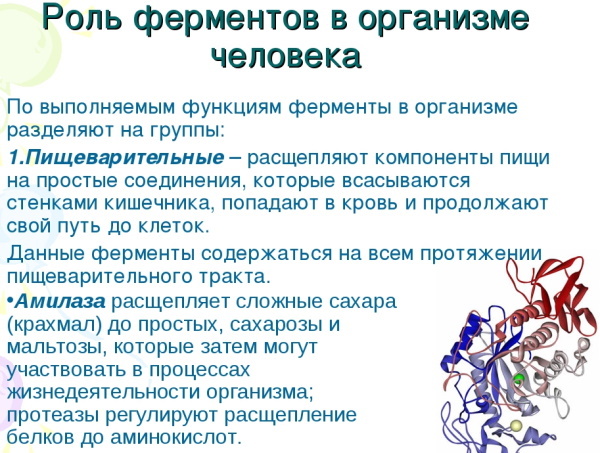
They also:
- Digest and digest food.
- Cleave and synthesize:
- nucleic acids;
- carbohydrates;
- proteins;
- fats.
- Affect:
- reproduction;
- breath;
- nerves and psyche;
- muscles.
Enzymes or enzymes are used in the following industries:
- tanning;
- pharmaceutical;
- food;
- textile.
Protein catalysts are also actively used:
- chemical industry;
- the medicine;
- Agriculture;
- pharmacology;
- biochemistry;
- Genetic Engineering;
- molecular biology.
Enzyme composition
Protein-catalysts contain:
- proteins;
- conferences (metal inclusions);
- coenzymes (vitamins).
Complex enzymes consist of a cofactor and an apoenzyme, while simple ones contain:
- lysozyme;
- pepsin;
- trypsin.
Enzyme nomenclature and classification
Enzymes in biology are accelerators of all chemical reactions in cells. They enhance metabolism and digestion. These compounds, which are also called enzymes, work with objects in the body (substrates) until the completion of their work. After that, they move on to the following goals.
All enzymes are individually numbered from 4 numbers:
- Class number.
- Subclass.
- Subsubclass.
- Sequential number in alphabetical order.
Features and properties of enzymes
Enzyme traits are:
- binding only to certain substrates or highly specific;
- dependence of activity on temperature and ph-level;
- high selectivity or selectivity;
- complex and unique protein structure;
- hypersensitivity to chemical compounds;
- highly efficient catalysis;
- acceleration of thermodynamic reactions;
- very low consumption.
The main properties of enzymes are:
- biological catalysis of protein origin;
- loss of activity and clotting during boiling;
- a gradual increase in the reaction rate;
- maintaining the temperature of the processes;
- dissolution in an aqueous medium and the creation of colloidal solutions;
- hydrolysis and denaturation;
- the possibility of splitting a huge amount of organic matter;
- thermal lability;
- absolute and relative specificity.
Functions and mechanism of action
Enzyme functions include:
- purposeful use of energy;
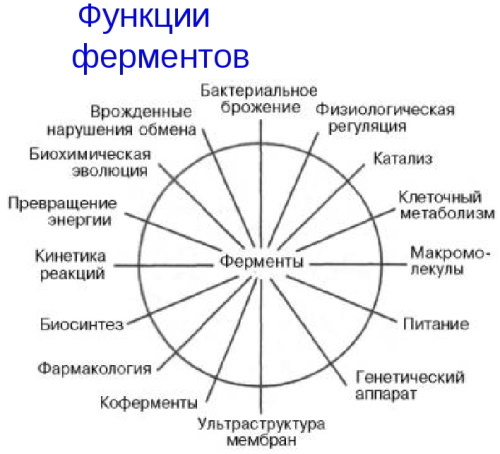
- a certain selectivity of the ongoing processes;
- a thousandfold acceleration of chemical reactions or catalysis;
- assistance in converting substrates into final products;
- protective, which neutralizes xenobiotics and endotoxins;
- regulatory, occurring in the cellular microspace;
- bacterial fermentation;
- metabolic;
- nutritious;
- genetic;
- pharmacological;
- biosynthetic;
- kinetic;
- biosynthetic.
Distribution in the body
Enzymes in biology are large proteins that number more than 4 thousand in their class. different types. They are combined into whole systems in order to then effectively influence internal bio-chemical processes.
Biocatalysts break down nutrients into smaller particles for further use by the body.
When interacting with other compounds in the body, enzymes create enzyme-substrate groups for a short time. At the end of the process, such complexes are broken down into end products and enzymes. Enzymes unchanged after this can bind further with other substrate molecules.
Depending on the performance and placement in the body, enzymes are:
- organelle-specific;
- organ-specific;
- universal.
General or universal enzymes:
- are found in almost all molecules of the body;
- catalyze the processes of protein biosynthesis;
- create living conditions for cells;
- accelerate energy exchange.
Organ-specific enzymes include:
- alanine aminotransferase;
- lipase;
- arginase;
- alpha amylase;
- urokinase;
- acid and alkaline phosphatase;
- histidase;
- sorbitol dehydrogenase;
- glutamyl transferase.
Organelle-specific enzymes are structured and colloidly dissolved in the cytosol.
They can be located in:
- ribosomes;
- cell nucleoli and centers;
- cytoplasm;
- mitochondria;
- cell membranes;
- lysosomes;
- microsomes.
Enzyme synthesis process
Enzyme synthesis is part of protein synthesis that genes regulate. In this case, enzymes are characterized by translation and transcription reactions.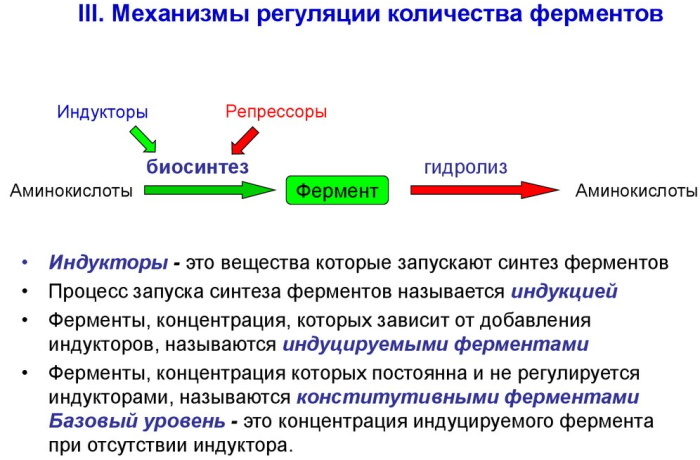
Enzymatic synthesis proceeds according to the following algorithm:
- DNA first gives out information about the required enzyme.
- Then the messenger RNA of all amino acids in the enzyme is encoded.
- When there is a sufficient amount of the product for catalysis, transcription is closed, and when it is deficient, on the contrary, it starts and is prolonged as long as necessary.
- After the release of messenger RNA into the cellular cytoplasm, translation occurs. On the endoplasmic line of ribosomes, the synthesis of the primary chain from peptide compounds and amino acids is formed. But at this stage, the protein molecule is not yet capable of doing its enzymatic work.
- Further, in the same network, the protein begins to twist, due to which secondary and tertiary structures are created.
- After that, some enzymes stop synthesis. But to enhance active catalysis, the inclusion of a cofactor and a coenzyme is required.
- The following organic elements of enzymes can be attached to individual sections of the endoplasmic membrane:
- nucleic acids;
- vitamins;
- monosaccharides;
- fats.
- For the formation of a quaternary protein structure to the domain group, inclusions of metal ions (cofactors) are required.
Sometimes a single reaction requires the presence of several enzymes that can function in different situations. Multiple forms of catalysts and isozymes are best suited for this. The former of these enzymes are formed post-translationally, while the latter are genetically formed.
Enzymes in biology are those elements of the body that, in the course of their work, do not have the property of being consumed. At a suitable temperature, the speed of such connections is greatly increased. Because of this, the reactions in which they participate are also accelerated.
Human enzymes and hereditary diseases
A large number of different processes are constantly going on in the human body. For the normal functioning of all internal systems, cells need enzymes that direct reactions along the right path.
. With insufficient activity of the enzyme or in its absence, various diseases begin to manifest themselves. These ailments are combined into a general group called fermentopathy.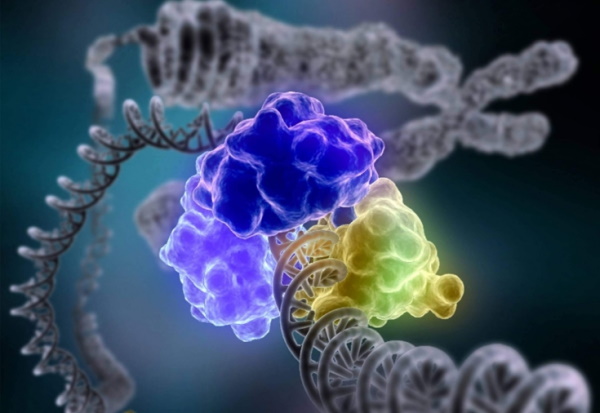
Among the types of hereditary diseases are:
- Lysosomal pathologies, due to which metabolism is disturbed and toxins accumulate. Such disorders include diseases:
- Teya-Sachs, with her weakness progresses, and then the nervous system completely fails;
- Hurler's syndrome, which causes developmental delay and the formation of abnormal structures in the bones;
- Crabbe, leading to developmental delays and damaging nerves;
- Niemann-Pika, in which nerves are damaged and the liver enlarged;
- Fabry, affecting only the male part of the population and characterized by pain in the limbs;
- Gaucher, leading to bone pain and enlargement of the liver.
- Accumulation of metals (hemochromatosis and Wilson's disease).
- Galactosemia, which appears due to a deficiency in the activity of the enzyme that converts galactose into glucose. As a result, this substance, together with phosphate, is not excreted from:
- cerebral cortex;
- blood serum;
- lens;
- erythrocytes;
- hearts;
- liver;
- muscles.
- Peroximal Disorders in the form of Zellweger's syndrome, expressed in:
- nerve damage;
- enlargement of the liver;
- the development of abnormal facial features.
- Leucinosis which leads to the accumulation of amino acid in the body.
- Frataxy, leading to:
- problems with walking;
- heart pain;
- nerve damage.
- Phenylketonuria, which is caused by the pathology of phenylalanine metabolism, which is why:
- thyroxine;
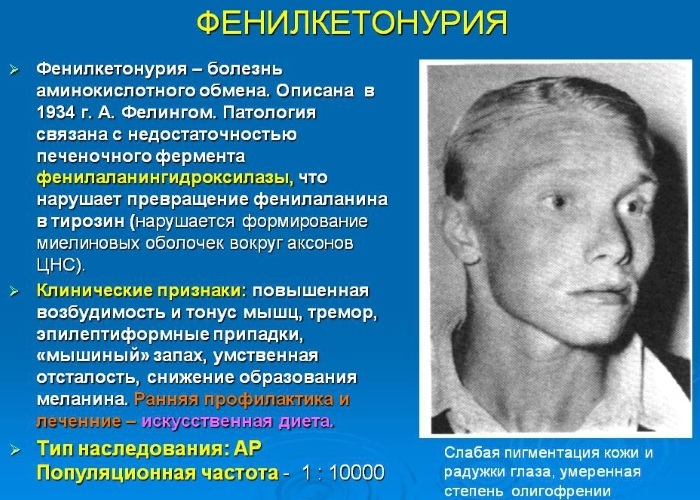
- adrenalin;
- tyrosine;
- melanin.
- Diseases associated with the accumulation of glycogen, with them:
- muscles are damaged;
- weakness appears;
- lowers blood sugar.
In children, at birth, the following hereditary metabolic disorders can be observed:
- Digestive problems due to enzyme breakdowns.
- Protein synthesis pathology.
- Diseases associated with impaired carbohydrate metabolism:
- glycogenosis;
- lactose deficiency;
- diabetes.
- Pathologies caused by malfunctions in amino acid metabolism:
- phenylketonuria;
- impaired steroid metabolism;
- albinism;
- alkaptonuria.
Hereditary metabolic disorders are manifested:
- thrombocytopenia;
- disruptions in the digestive system;
- mental retardation;
- enlargement of the spleen and liver;
- disorders in the nervous system;
- cataracts;
- convulsions and coma;
- changes in the condition of the skin and hair;
- specific body and urine odor;
- skeletal abnormalities;
- muscle lesions;
- immunodeficiency;
- athetoses;
- myopathy;
- ketoacidosis relapses.
For fermentopathies with a hereditary nature in young children, symptoms are characteristic:
- Galactosemia:
- cataract;
- cirrhosis of the liver;
- fatty infiltration;
- growth retardation;
- diarrhea;
- vomit;
- jaundice.
- Phenylketonuria:
- paresis;
- ataxia;
- seizures;
- drowsiness and irritability;
- lag in physical and mental development.
- Cystic fibrosis:
- bloated belly;
- pallor;
- constant regurgitation;
- anxiety;
- lethargy;
- dyspnea;
- weakness.
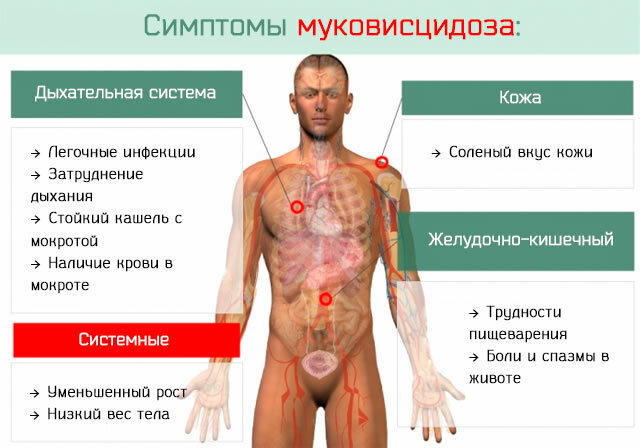
Cystic fibrosis. Symptoms
- Celiac disease:
- general discomfort;
- pain in the stomach;
- vomiting and nausea;
- lag in weight and height;
- excitability.
- Lactose deficiency:
- stomach ache;
- increased gas formation;
- diarrhea.
Enzymes support the health of the body by helping it separate incoming food into nutrients. In biology, this process is called cleavage. Enzymes also release energy from food and deliver it further to the cells. But these compounds are found not only inside the body, but also in some fermented foods.
Hereditary enzymopathies are usually caused by factors such as:
- cell receptor defects and membrane disorders;
- lack of a gene with which enzymes are formed;
- errors in gene molecules.
Therapy for genetic fermentopathies consists of:
- detoxification of harmful metabolic products by introducing chemicals into the blood;
- the use of special supplements with enzymes to improve material metabolism;
- the introduction of diets to exclude certain nutrients.
Interesting Facts
Among the well-known as well as interesting facts about enzymes are the following:
- Biocatalysts soften the substrate and make it more flexible. They literally dissolve the objects of their influence and impregnate them with their secretions.
- Enzyme molecules contain hundreds and thousands of atoms:
- nitrogen;
- phosphorus;
- carbon;
- oxygen;
- hydrogen.
- Even in non-living organisms, enzymes continue to work. But they do it already in a disorderly manner. In this case, these substances begin to self-digest, thereby including the autolysis process. This reaction completely or partially cleaves all remaining compounds.
- Biological degradants are most needed by athletes and exercising people. This is due to the fact that an accelerated metabolism is observed in their bodies, as a result of which there is a rapid depletion of reserves of their own enzymes.
- Biocatalysts are also necessary for the rejuvenation of the body. After all, a sufficient amount of enzymes prevents aging and dryness of the skin, and also gives it:
- shine;
- freshness;
- tenderness;
- elasticity.
- Milk in the body processes lactase. It begins to be produced inside a person as early as infancy. This assimilation of milk compensates for the vitamin D deficiency and helps to maintain health for a long time.
- The enemies of enzymes that can destroy them are:
- beans;
- potatoes with sprouts that have already appeared on it;
- peas;
- lentils;
- egg white.
- Protein-enzymatic synthesis occurs on ribosomes.
- The science of bio-catalysts is not enzymology, but enzymology.
- The most important enzymes are for the food industry and agriculture.
- Enzymatic reactions first became known and studied in the fermentation industry.
- Enzymes also play an important role in blood clotting.
- Physiologist Pavlov gave the enzymes the name "carriers of life."
- Thanks to enzymes, the body can easily cope with digestive reactions.
- A huge number of known biological converters inside the body:
- heal wounds;
- renew worn-out cells;
- protect against pathogenic microbes;
- transform food into building materials and energy;
- neutralize foreign compounds and exchange waste.
- The main suppliers of hyaluronic acid and collagen to the skin are enzymes such as:
- hyaluronidase;
- trypsin;
- lipase;
- bromelain;
- collagenase;
- SOD;
- papain.
- In 2009 American scientists have invented telomerase, which prolongs the life of cells. Shortly thereafter, the discovery was awarded the Nobel Prize. Thanks to the new enzyme, cells do not change or age.
- The enzymes themselves were first discovered in the 16th century. Dutch J. B. Van Helmont.
Without enzymes, not a single vital reaction occurs in the body. It is known from the course of biology that these substances are ranked 3rd in importance after oxygen and water. Enzymes are extremely important, as they allow a person to cope with many internal processes. People need to constantly monitor the amount and level of these substances.
Videos about enzymes in biology
Enzymes and their role in the human body:

